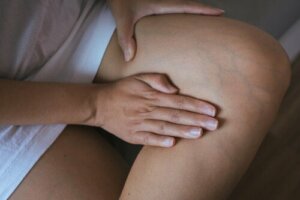How to Avoid Fluid Retention and Reduce Swelling


Reviewed and approved by the pedagogue in physical education and nutritionist Elisa Morales Lupayante
One thing we know about fluid retention is that it’s usually caused by the accumulation of water in the body’s tissues. What causes it? Normally, it’s due to an imbalance between the flow of fluids from one region to another.
Your body is constantly adjusting its liquid levels to keep them in the correct proportions. When you drink more water than you need, the excess is removed through your kidneys in the form of urine or sweated out through your skin.
Problems arise when your body isn’t able to get rid of any excess fluid. The balance becomes unsustainable and causes fluid retention.
Hydration and edema

As the article “Hydration and physical exercise” points out, edema is a clear example of the storage of water in the body that manifests itself mainly in the legs. In this sense, we should note that circulation needs to be stronger in the legs for proper functioning and, therefore, where the imbalances occur the most.
The MedlinePlus Medical Encyclopedia points out that, generally, edema is induced by a hormonal situation dominated by estrogens, an excess of sodium in the diet, and poor blood circulation due to sedentary lifestyle, among other causes.
If this fluid retention is also located in the upper body (with possible edema in the arms, hands, and even the face), it could be due to poor kidney function.
Keep in mind that, in women, it’s quite normal for fluid retention to occur during the menstrual cycle. Therefore, you don’t need to get alarmed if it’s temporary.
Don’t forget to read: Decrease Fluid Retention with Fruit and Vegetables
The function of veins
Your veins, contrary to what you might think, aren’t sealed channels. The lining of your veins also allow for the entry and exit of fluids. Sometimes, for a variety of reasons, the mechanism that regulates this flow of fluids doesn’t work properly and they can accumulate in certain parts of the body.
Why does this happen? It could be due to several reasons. Mainly, because the veins don’t have the consistency needed to retain fluids, which happens when varicose veins appear. However, they may also occur because you’ve been standing too long.
Signs of fluid retention
A clear test for fluid retention is when you press against the skin on your legs and notice that there’s a noticeable dent where you apply the pressure. You’ll see a kind of groove, and it takes a second for the skin to smooth back out.
If fluid retention occurs frequently and there’s visible edema, it’s best to see a doctor for an evaluation. This way, complications that may be related to circulation can be detected and prevented.
Do you want to know more? Read: Fight Fluid Retention with These 5 Delicious Diuretic Smoothies
Some tips to end with fluid retention

The Spanish Heart Society explains that both sports and physical exercise are essential to relieve or avoid fluid retention. Exercises that don’t require high resistance or cause a strong muscular impact are best.
Physical activity activates circulation throughout your body, especially in the legs, through the compression of the muscles against the veins. Thus, it’ll help relieve swelling and other discomforts.
- Compression stockings can also help prevent fluid retention, especially for people who lead very sedentary lifestyles, either because they’re always sitting down or standing up.
- Some fruits and vegetables (such as grapes) have a decongestant effect on circulation.
- Pineapple and papaya and other fruits that are rich in potassium, like bananas, melon, and watermelon, are very good dietary choices if you have a tendency to retain fluids.
- To improve the appearance of swollen ankles, try elevating your legs, which can be very helpful at different times of the day.
- The clothing you wear should also be comfortable. Excessively tight garments make movement more difficult and encourage fluid retention.
- You need to get used to consuming less salt. Although your body does require a certain amount of sodium, too much of it can worsen fluid retention.
- It’s a good idea to add aromatic herbs and plants that double as diuretic ingredients to your diet. Some good examples include horsetail grass, green tea, and dandelion tea, among others.
Putting all of these tips and instructions from your family doctor into practice, you won’t only prevent or relieve fluid retention but you’ll also gain overall health and well-being.
All cited sources were thoroughly reviewed by our team to ensure their quality, reliability, currency, and validity. The bibliography of this article was considered reliable and of academic or scientific accuracy.
- José M. Rosés. Pere Pujol. Hidratación y ejercicio físico. http://www.audyn.org.uy/sitio/repo/arch/apunts.pdf
- MedlinePlus. Edema. https://medlineplus.gov/spanish/edema.html
- Asociación Española de Pediatría. MARCADORES CLÍNICOS DE ENFERMEDAD RENAL. INDICACIÓN E INTERPRETACIÓN DE LAS PRUEBAS COMPLEMENTARIAS. RECOGIDA DE MUESTRAS Y ANÁLISIS SISTEMÁTICO DE LA ORINA. https://www.aeped.es/sites/default/files/documentos/01_marcadores_enf_renal.pdf
- El Sevier. Sistema cardiovascular, anatomía general: arterias y venas. https://www.elsevier.com/es-es/connect/medicina/sistema-cardiovascular-anatomia-general-arterias-venas
- Sociedad Española del Corazón. Soluciona la retención de líquidos. https://fundaciondelcorazon.com/corazon-facil/blog-impulso-vital/2649-soluciona-la-retencion-de-liquidos.html
This text is provided for informational purposes only and does not replace consultation with a professional. If in doubt, consult your specialist.








